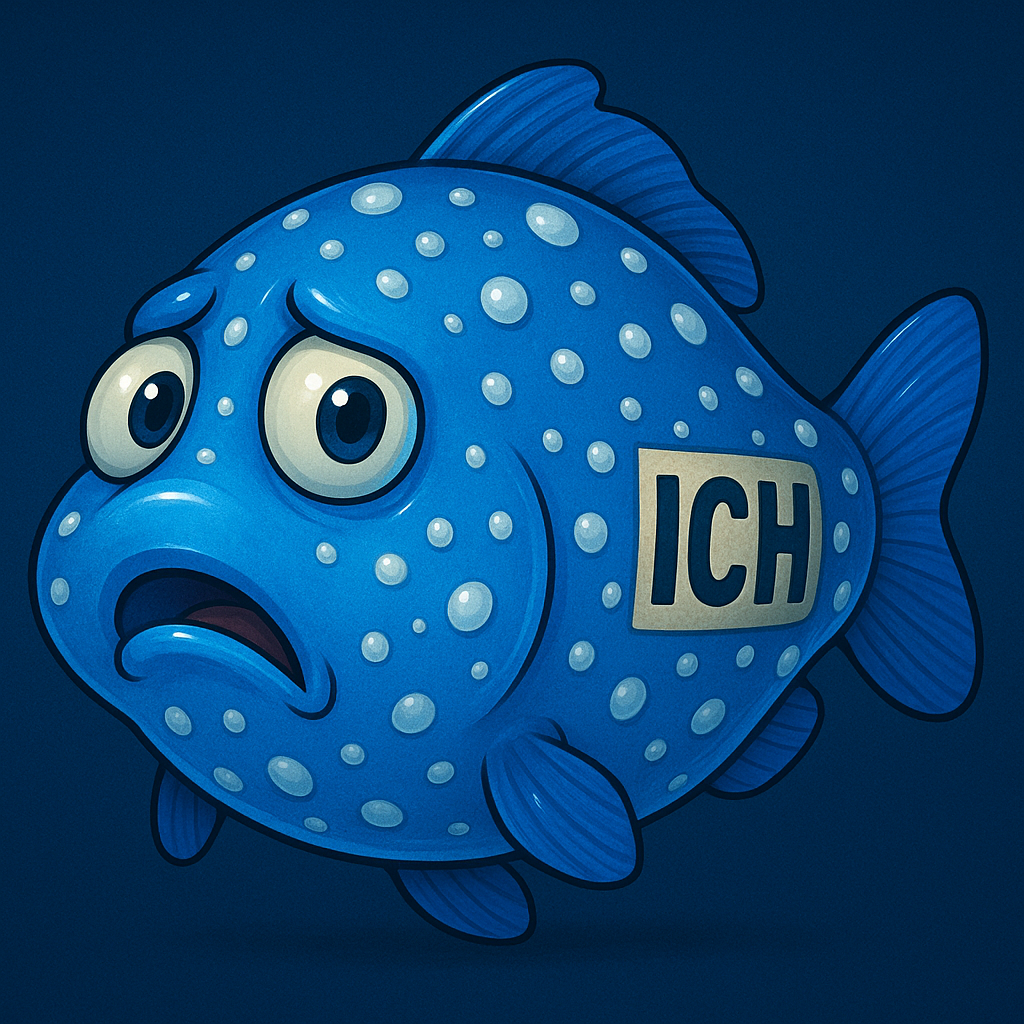What is ich?
🐟 What Is Ich on Aquarium Fish and How Do I Get Rid of It?
Ich, also called Ichthyophthirius multifiliis or "white spot disease," is one of the most common aquarium fish diseases. It’s caused by a parasitic protozoan that attaches to your fish’s body, gills, and fins.
🔎 How to Recognize Ich
- ❄️ White spots (like grains of salt or sugar) on the fish’s body, fins, or gills
- 🐠 Fish may scratch or flash against rocks, glass, or substrate
- 🫁 Labored breathing if parasites attack the gills
- 😟 Lethargy and loss of appetite
- 🤿 Fish may stay near the surface or hide more than usual
🦠 Ich Life Cycle (Why Treatment Takes Time)
- Trophont (on the fish): Parasite burrows into the skin or gills (not treatable at this stage).
- Tomont (in the substrate): Parasite falls off and forms a cyst, multiplying rapidly.
- Theront (free-swimming): Newly hatched parasites search for a host. This is when treatments work.
👉 Because only the free-swimming stage is vulnerable, treatment must last long enough to target all life cycles.
💊 How to Treat Ich
1. 🐟 Treat in the Same Tank (When Possible)
- In most cases, it’s best to treat Ich in the tank the fish is already in.
- Moving a sick fish adds extra stress, which weakens its ability to fight infection.
- ✅ However, if the fish is severely lethargic, struggling to breathe, or at risk of being bullied, moving it to a quarantine tank may be necessary.
- Use your judgment — the main goal is reducing stress while treating effectively.
2. 🧪 Medication
- Use a trusted Ich-specific treatment (often copper-based or malachite green + formalin).
- Secondary infections: Ich damages the skin and gills, which opens the door for bacterial, fungal, or viral infections.
- Because of this, it’s smart to have two types of meds on hand:
- One that’s Ich-specific
- One that’s a broad-spectrum medication that covers multiple pathogens
- Because of this, it’s smart to have two types of meds on hand:
- ⚠️ Scaleless fish (like loaches, catfish, eels) and fish with tiny scales are highly sensitive. Always use half-dose, unless the medication specifically says full strength is safe.
- ⚠️ Invertebrates (shrimp, snails, crayfish) are very sensitive to many Ich medications.
- Make sure the product is safe for inverts, or move them to a temporary tank while treating.
- ❌ Do not waste money on MelaFix or PimaFix.
- Some people swear by them, but there is no scientific proof they cure Ich or other infections.
- All they do is make the water smell like tea tree oil, and in some cases, they can even suffocate fish by coating their gills.
- Remove carbon from filters, as it can absorb medication.
3. 🌡️ Adjusting Temperature
- Raising the temperature is not always required, but if Ich is persistent, it can help.
- Slowly increase temp to 82–86°F (28–30°C) if your fish can tolerate it.
- Increasing temp speeds up the parasite’s life cycle, making medication more effective.
- ⚠️ Raise the temperature gradually to avoid shocking your fish.
4. 🚿 Water Changes + Gravel Cleaning
- While treating, do water changes every other day (not huge ones — just enough to siphon the gravel).
- This helps remove cysts that settle in the substrate.
- After each water change, re-dose medication as directed.
- Treat for a full 2 weeks, even if spots disappear sooner.
- Just because you can’t see Ich doesn’t mean it’s gone — parasites may still be in the substrate or free-swimming.
- Keep monitoring your fish closely after treatment ends.
5. 💦 Aquarium Salt (optional, freshwater only)
- Add aquarium salt if species tolerate it.
- Salt reduces stress and helps fight parasites.
6. 🪣 Maintain Excellent Water Quality
- Keep ammonia and nitrite at 0 ppm.
- Strong aeration is important when using meds and higher temps.
🛡️ Prevention
- 🐟 Quarantine new fish for at least 2–4 weeks before adding to your main tank.
- 🌿 Disinfect plants, decorations, and equipment before use.
- 🚫 Avoid cross-contamination: Use separate nets, buckets, siphons, and equipment for each tank.
- 🧼 Disinfect after each use: Spray nets, buckets, or other tools with hydrogen peroxide or alcohol. Let sit several minutes, rinse/air dry before reusing.
- ✋ Sanitize your arms: If you reach into multiple tanks, spray your arms/hands with disinfectant, wait, and dry before putting them into another tank.
- 🕯️ Keep stress low: Quarantine tanks should have low/no light, minimal vibrations, and no tapping on the glass.
- 🩺 Always treat early — the sooner Ich is detected, the easier it is to cure.
⚠️ Important to Know
- Even after treatment, Ich can come back if stress or poor water conditions weaken fish.
- ✅ It works… until it doesn’t — what cures Ich once may not prevent it next time.
- ⚠️ Ich is dangerous not only by itself but also because it can lead to secondary infections that require additional medication.
✨ In summary: Ich is stubborn but beatable. With consistent treatment (full 2 weeks), careful dosing, broad-spectrum backup meds, invert safety, gravel siphoning, and stress reduction, your fish have a strong chance of recovery.

Powered by Lightspeed
Display prices in:USD